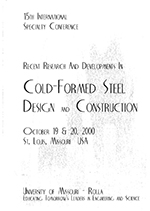Session Dates
19 Oct 2000
Abstract
In Australia, sandwich panels are commonly made of flat or lightly profiled steel faces and expanded polystyrene foam cores. Flexural wrinkling is often the governing criterion in the design of these panels. The use of lightly profiled faces is expected to increase the flexural wrinkling stress considerably whereas the presence of joints between the polystyrene foam slabs in the transverse direction introduces a reduction to the flexural wrinkling stress. Therefore a series of full scale experiments and finite element analyses were conducted to evaluate the effects of lightly profiled faces and transverse joints on the flexural wrinkling stress of panels subjected to a lateral pressure loading. This paper presents the details of this investigation, the results and comparison with available theoretical and design solutions.
Department(s)
Civil, Architectural and Environmental Engineering
Research Center/Lab(s)
Wei-Wen Yu Center for Cold-Formed Steel Structures
Meeting Name
15th International Specialty Conference on Cold-Formed Steel Structures
Publisher
University of Missouri--Rolla
Document Version
Final Version
Rights
© 2000 University of Missouri--Rolla, All rights reserved.
Document Type
Article - Conference proceedings
File Type
text
Language
English
Recommended Citation
Mahendran, Mahen and McAndrew, D., "Flexural Wrinkling Behaviour of Lightly Profiled Sandwich Panels" (2000). CCFSS Proceedings of International Specialty Conference on Cold-Formed Steel Structures (1971 - 2018). 1.
https://scholarsmine.mst.edu/isccss/15iccfss/15iccfss-session5/1
Flexural Wrinkling Behaviour of Lightly Profiled Sandwich Panels
In Australia, sandwich panels are commonly made of flat or lightly profiled steel faces and expanded polystyrene foam cores. Flexural wrinkling is often the governing criterion in the design of these panels. The use of lightly profiled faces is expected to increase the flexural wrinkling stress considerably whereas the presence of joints between the polystyrene foam slabs in the transverse direction introduces a reduction to the flexural wrinkling stress. Therefore a series of full scale experiments and finite element analyses were conducted to evaluate the effects of lightly profiled faces and transverse joints on the flexural wrinkling stress of panels subjected to a lateral pressure loading. This paper presents the details of this investigation, the results and comparison with available theoretical and design solutions.



